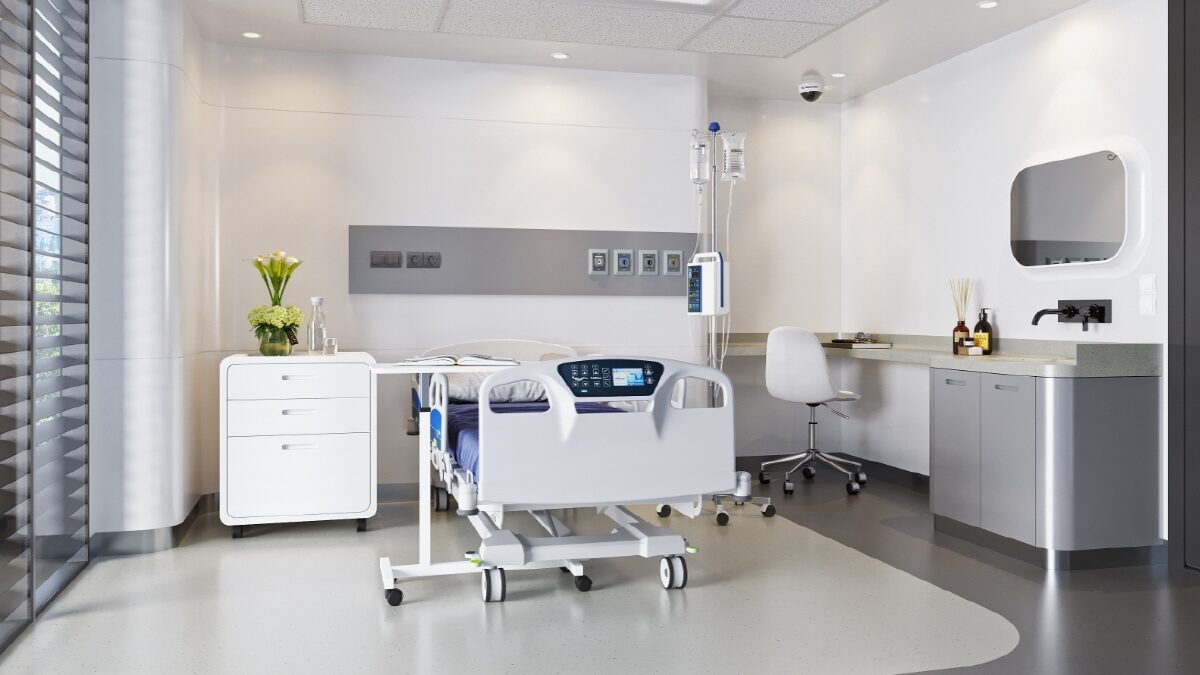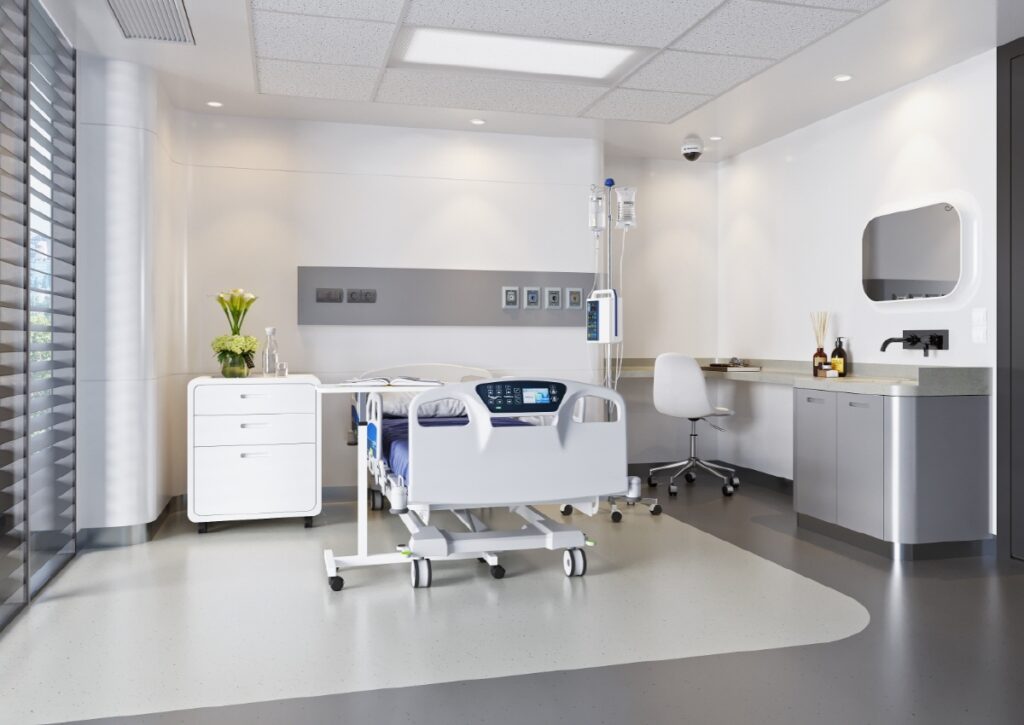
When it comes to choosing the right flooring product for hospitals, several critical factors need to be considered to ensure that the chosen material meets the unique demands of that kind of facility. Hospitals require a flooring solution that is not only durable and easy to clean but also promotes a hygienic and safe environment for patients, staff, and visitors.
-
Cleanability: The flooring should be easy to clean and disinfect, as hospitals are often dealing with infectious diseases.
-
Durability: The flooring should be able to withstand heavy foot traffic and other wear and tear.
-
Comfort: The flooring should be comfortable for patients and staff to walk on.
-
Aesthetics: The flooring should complement the overall design of the hospital.
-
Load requirements: The flooring should be able to support the weight of heavy equipment, such as hospital beds and X-ray machines.
Entryways and lobbies: Vinyl flooring and more
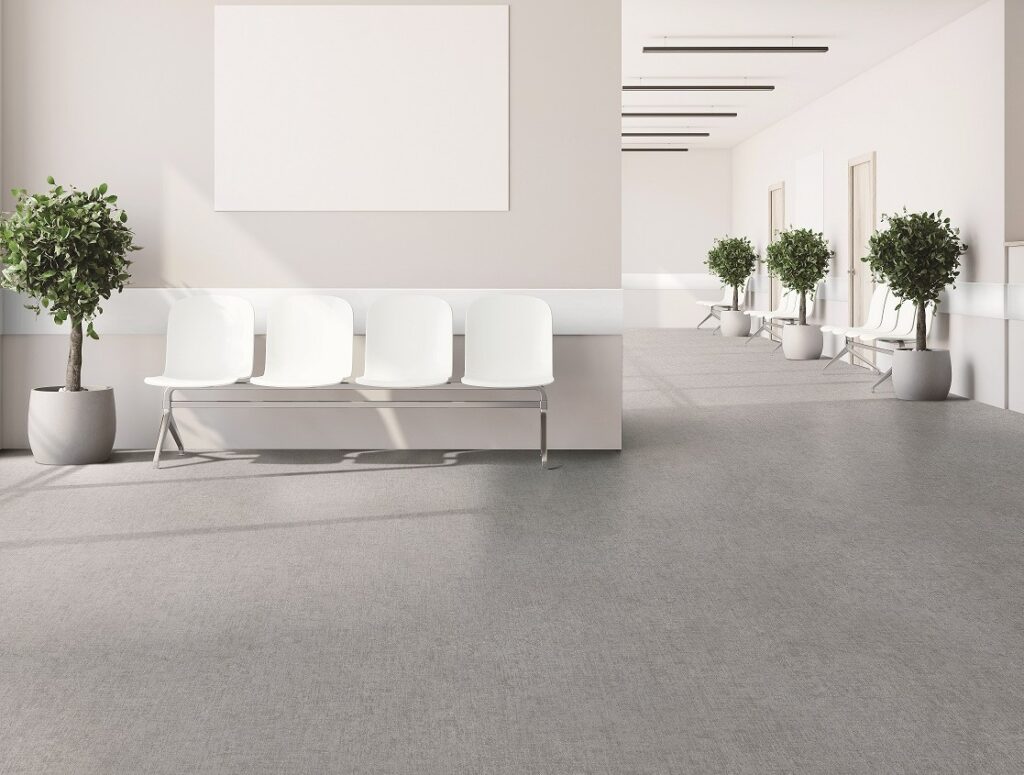
Luxury Vinyl Tile (LVT)
LVT is a versatile flooring material known for its low maintenance and durability. It comes in a wide range of designs, including wood, tile, stone, and concrete looks, making it suitable for both urban and rural hospitals. LVT is easy to install, highly durable, essentially waterproof, and is ideal for high-traffic areas.
Vinyl Composite Tile (VCT)
VCT is made up of natural limestone, fillers, color pigments, and a thermoplastic binder. It is an economical option known for its extreme durability. Because of its seamless installation and dense surface structure, it is suitable for high levels of pedestrian traffic and rolling loads. Though it is exceptionally durable, VCT requires more maintenance (stripping, waxing, and polishing) than conventional vinyl flooring. Because of this, its life cycle expenses should be analyzed and taken into account.
Rubber
Rubber flooring offers a smooth installation, unmatched durability, and numerous design options. This makes it a fantastic option for elevating interior designs. What’s more, it can withstand the toughest hospital conditions without sacrificing style. It is particularly desirable because of its sound absorption capabilities and softness underfoot. Another advantage is that upkeep is minimal. In fact, rubber can actually self-heal from some minor scratches or indentations. This highly versatile product is suitable for high-traffic locations due to its exceptional performance and durability.
Bamboo
While bamboo flooring may not be the best option for high-traffic areas due to its relatively high price point, it is a great option for adding a special touch to hospital offices, chapel areas and other specialty spaces that need a higher degree of aesthetics. Keeping bamboo’s beautiful and natural look intact requires plenty of high maintenance and attention. Moreover, bamboo is a bit more costly to install compared to other types of flooring, which further limits its use to specific spaces within a hospital setting.
Commercial carpet
Commercial carpet was once the predominant flooring used in hospital settings due to its appearance, its cushion underfoot and a virtually limitless variety of colors and patterns. Today, however, it is being used less and less due to the required maintenance and cleaning, as well as concerns about its lack of hygienic properties. Although carpet offers reliable sound absorption and a cozy, comfortable feel, hospitals today need a flooring solution that is easy to maintain, highly durable and long-lasting
ICUs and Operating Rooms: Sheet vinyl and rubber flooring
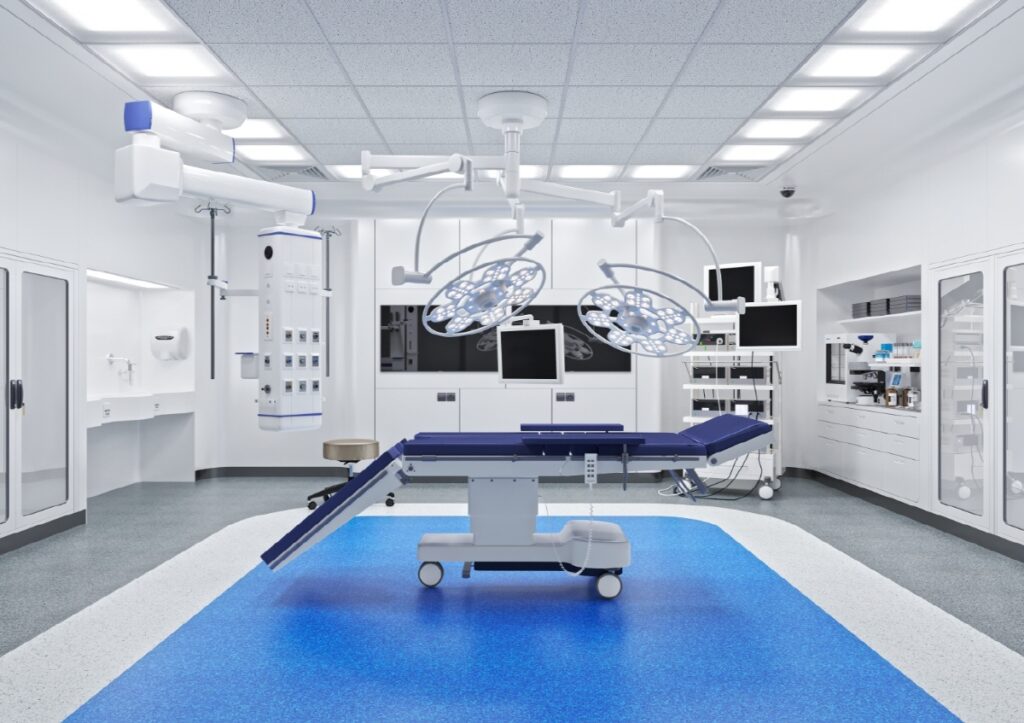
Sheet vinyl
Sheet vinyl is ideal for procedural rooms and surgical suites due to its monolithic features, its easy cleanability, and its ability to repel microorganisms. It stands out as a top choice for these critical areas due to its seamless installation and ability to withstand fluid exposure while providing a clean and sterile environment.
Linoleum
Linoleum may seem like a flooring option from the past, but contemporary production techniques have allowed it to be produced in a broad range of hues and designs, making it an appealing choice for many hospitals today. Linoleum is a highly sustainable flooring product with strong antimicrobial properties. This makes it highly suitable for hospital and healthcare settings. Additionally, its natural composition protects against germs, allowing it to be a highly viable option for patient rooms.
Corridors: Vinyl and rubber flooring
Corridors in hospitals face continuous heavy foot traffic and rolling loads from stretchers, wheelchairs, equipment carts, and medical carts. Flooring products in hospital corridors need to be installed quickly and maintain a high level of durability to reduce disturbances. Vinyl and rubber flooring are excellent options for these areas, as they combine durability, ease of maintenance, and aesthetic appeal.
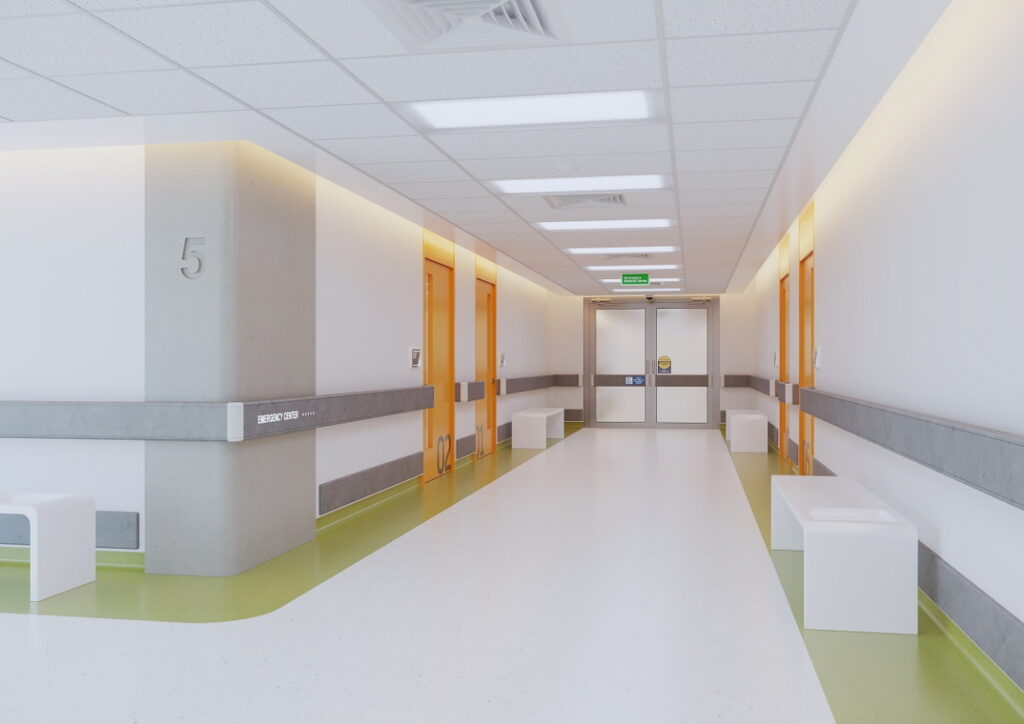
Luxury Vinyl Tile (LVT)
As mentioned earlier, LVT offers durability and design versatility, making it suitable for hospital corridors. Its ability to mimic soothing natural textures, such as wood, stone, and more, ensures a welcoming environment. LVT comes with pre-applied adhesive on the backings, which makes its application and installation easy and hassle-free.
Rubber
Rubber is an excellent choice for corridors as it provides noise reduction, durability, and ease of maintenance. Like LVT, it also comes with pre-applied adhesive on the backings, making installation easier.
Patient rooms: Vinyl and linoleum flooring
Patient rooms in hospitals should provide a warm and home-like environment to aid the healing process. Both aesthetics and the high amount of foot traffic are important factors to consider when choosing flooring for hospital patient rooms. Vinyl and linoleum flooring provide a seamless surface that is easy to clean, which can help reduce the risk of infection.
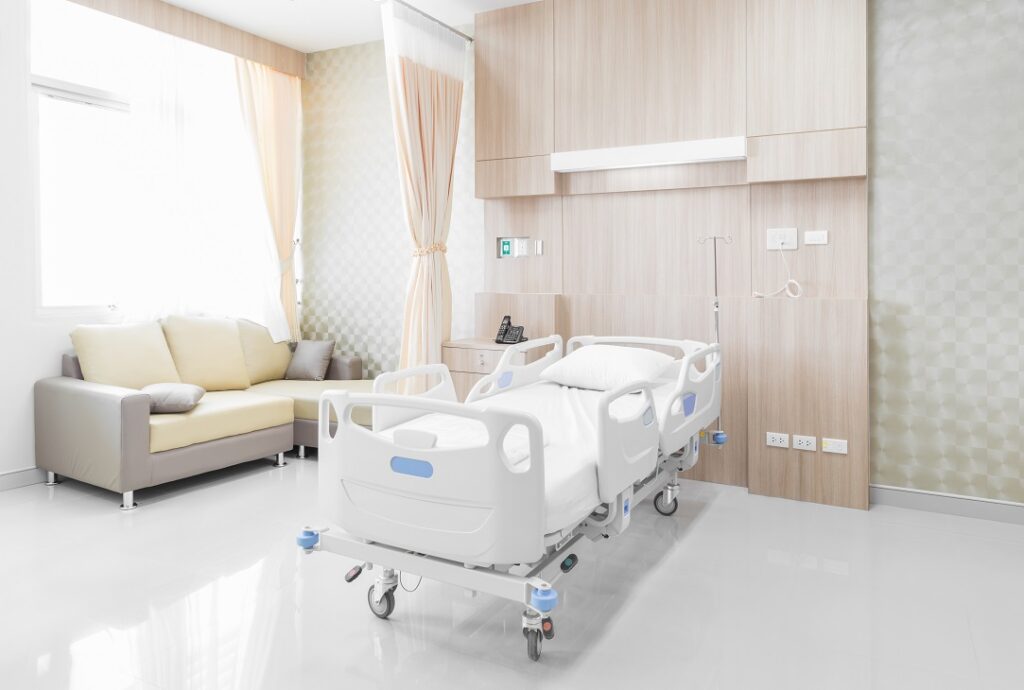
Luxury Vinyl Tile
With a few exceptions, LVT may be placed in almost any hospital room setting and only needs simple upkeep. It is an excellent choice for patient rooms due to its design versatility and low maintenance. As a highly durable product too, it can withstand some of the most heavy-load-bearing requirements as well.
Sheet Vinyl
Since there is always a risk of spills or contamination in patient rooms, sheet vinyl flooring is a strong option because of its ability to be easily cleaned and disinfected. Sheet vinyl flooring comes in large rolls, thus minimizing the number of seams and making it a great option for patient rooms where both germ prevention and patient fall prevention is a key concern. One drawback to sheet vinyl is that if one section of the flooring is damaged, that section can not be replaced with a new section; the whole floor must be replaced. This can make maintenance with sheet vinyl costly and time-intensive.
Linoleum
Linoleum is a natural and eco-friendly option with several environmental qualities and benefits. When installed and properly sealed, it is water-resistant and one of the most durable options you can choose. This alone makes it a great choice for patient rooms and several other hospital settings.
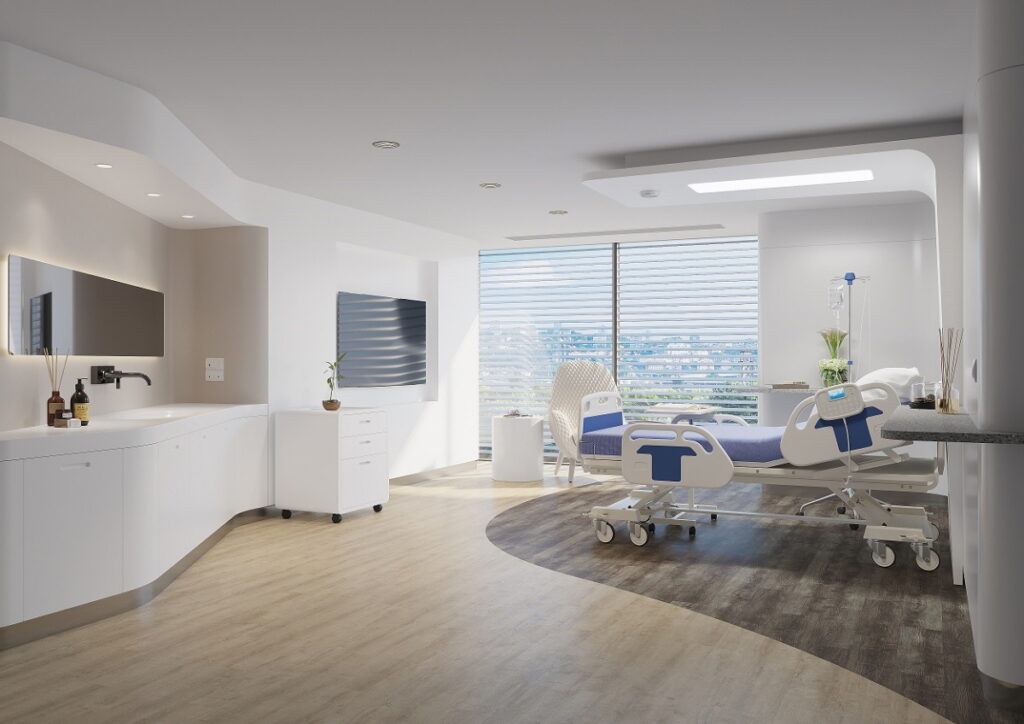
Get advice for your hospital flooring: Through LX Hausys
By considering all of these factors, hospitals can install a flooring that best meets the needs of patients, staff, and visitors alike. For advice on choosing the right hospital flooring product, you can consult with an LX Hausys expert. Please use our contact form to get in touch with an expert today to get the answers you need.

